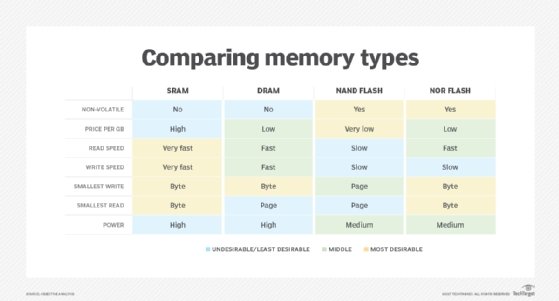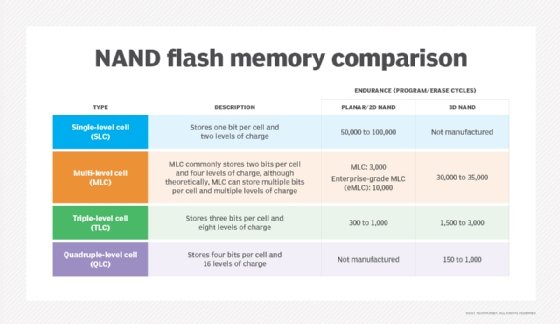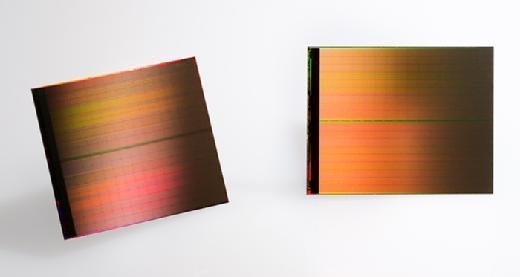non-volatile storage (NVS)
What is non-volatile storage (NVS)?
Non-volatile storage (NVS) is a broad collection of technologies and devices that do not require a continuous power supply to retain data or program code persistently on a short- or long-term basis.
Non-volatile storage technologies and devices vary widely in the manner and speed in which they transfer and retrieve data, whether communicating with an application, microprocessor or other type of device. They can also vary significantly in terms of cost, capacity, endurance and latency.
Non-volatile storage is often categorized by the following two system types:
- Electrically addressed systems. These NVM systems use electrical mechanisms to program (write) and read data. Electrically addressed systems include flash memory, read-only memory (ROM) and ROM variations.
- Mechanically addressed systems. These NVM systems use a head to write and read data to magnetic storage media. Mechanically addressed systems include hard-disk drives (HDDs) and tape drives.
Most of today's solid-state drives (SSDs) are equipped with NAND flash memory chips. An SSD is considered an electrically addressed system because it uses electrical mechanisms to write and read data. As a result, the SSD can deliver faster speeds and lower latency than a mechanically addressed system such as an HDD. However, the per-byte price to store data in a flash-based SSD is generally higher than the per-byte cost of an HDD or tape drive. In addition, flash SSDs can sustain only a limited number of write cycles before they wear out.
What are non-volatile storage examples?
Three common examples of NVS devices that persistently store data are tape drives, HDDs and SSDs. The term non-volatile storage also applies to the semiconductor chips that store data or controller program code within devices such as SSDs, HDDs, tape drives and memory modules.
Many types of non-volatile memory chips are in use today. For instance, the SSDs in enterprise and personal computer systems typically use NAND flash memory chips to store data. The chips are also used in USB sticks and memory cards in consumer devices such as mobile telephones and digital cameras. NOR flash memory chips commonly store controller code in storage drives and personal electronic devices.
Volatile vs. non-volatile storage devices
The key difference between Volatile and non-volatile storage devices is whether or not they are able to retain data in the absence of a power supply. Volatile storage devices lose data when power is interrupted or turned off. By contrast, non-volatile devices are able to retain data regardless of the status of the power source.
Common types of volatile storage include static random access memory (SRAM) and dynamic random access memory (DRAM). Manufacturers may add battery power to a volatile memory device to enable it to persistently store data or controller code, but if the battery fails or is removed, the data is still lost.
Enterprise and consumer computing systems often use a mix of volatile and non-volatile memory technologies, and each memory type has advantages and disadvantages. For instance, SRAM is faster than DRAM and well suited to high-speed caching, but it is expensive to manufacture. DRAM is less expensive to produce and requires less power than SRAM, and manufacturers often use it to store program code that a computer requires immediate access to in order to operate efficiently.

By contrast, non-volatile storage such as HDDs and SSDs is slower than SRAM and DRAM but is cheaper to produce. Manufacturers commonly use NAND flash memory to store data persistently in business systems and consumer devices. Storage devices such as flash-based SSDs access data at a block level, whereas SRAM and DRAM support random data access at a byte level.
Like NAND, NOR flash is less expensive to produce than volatile SRAM and DRAM. NOR flash costs more than NAND flash, but it can read data faster than NAND, making it a common choice for booting consumer and embedded devices and for storing controller code in SSDs, HDDs and tape drives. NOR flash is generally not used for long-term data storage due to its poor endurance.
Trends and future directions
Manufacturers are working on additional types of non-volatile storage to try to lower the per-bit cost to store data and program code, improve performance, increase endurance levels and reduce power consumption.
For instance, manufacturers developed 3D NAND flash technology in response to physical scaling limitations of two-dimensional, or planar, NAND flash. 3D NAND can deliver higher densities at a lower cost per bit by vertically stacking memory cells, rather than using a single layer of cells.

Over the years, manufacturers have also been increasing the number of bits per cell in NAND flash storage.
- Single-level cell (SLC). Each cell contains only one bit. This configuration is the fastest, most durable and least prone to error. It's also the most expensive. For mission-critical workloads, however, it might well be worth the price.
- Multi-level cell (MLC). Each cell contains exactly two bits, even though the name indicates otherwise. MLC devices are not as fast, reliable or durable as SLC storage, but they're more affordable and are well suited for many types of enterprise workloads. MLC devices are what made it possible for standard laptop and desktop computers to start incorporating SSDs, and they're still used extensively in business computers.
- Triple-level cell (TLC). Each cell contains three bits. The TLC technology sacrifices speed, reliability and durability even further, but it also increases densities and lowers the per-gigabyte cost of storage. TLC devices are now the predominant type of SSD storage used in consumer systems. They're also used in many business systems and data centers, rather than MLC storage.
- Quad-level cell (QLC). Each cell contains four bits. Once again, the additional bits impact speed, reliability and durability, but they also make SSD storage more affordable. However, because of the durability issues, QLC devices are often better suited to read-intensive workloads, such as analytics, video streaming or big data analytics.
By increasing the number of bits per cell, flash-based SSDs can hold more data, resulting in lower prices, reduced power consumption and smaller footprints. Multi-cell configurations are also used in conjunction with 3D NAND to increase capacities even further. In addition, manufacturers are actively working on penta-level cell (PLC) flash, which squeezes five bits per cell, although it could still be several years before PLC devices hit the market.

Manufacturers have also been working on storage solutions that bridge the gap between traditional volatile system memory and flash-based SSDs, providing an additional tier in the storage hierarchy. The most notable effort has been the 3D XPoint project co-developed by Intel Corp. and Micron Technology Inc. 3D XPoint offers higher throughput, lower latency, greater density and improved endurance over NAND flash technology.
Intel was the first to offer products based on 3D XPoint, shipping them under the brand name Optane, which includes a line of SSDs and persistent memory modules intended for data center use. Persistent memory modules are also known as storage class memory.

Non-volatile memory express (NVMe) technology has also proved to be a game-changer in the storage industry. NVMe makes it possible to connect flash-based SSDs directly to a computer's PCI Express (PCIe) bus, rather than connecting through Serial Attached SCSI (SAS) or Serial ATA (SATA) interfaces. These older technologies were built for slower HDDs and cannot take full advantage of the SSD's capabilities. NVMe can also be used in conjunction with newer options such as Optane SSDs, further accelerating performance and reducing latency and power consumption.
NVMe offers a more streamlined command set to process input/output (I/O) requests with PCIe-based SSDs than the Small Computer System Interface (SCSI) command set does with SAS drives or the analog telephone adapter (ATA) command set does with SATA drives.
The success of NVMe led to the development of NVMe over Fabrics (NVMe-oF), a specification that was created to support the use of the NVMe command set when transferring data between SSDs and other systems over a network fabric such as Ethernet, Fibre Channel or InfiniBand. According to NVM Express Inc., 90% of the NVMe-oF protocol is the same as basic NVMe.

Emerging non-volatile storage technologies currently in development or in limited use include phase-change memory (PCM), ferroelectric RAM (FRAM or FeRAM), magnetoresistive RAM (MRAM), resistive RAM (RRAM or ReRAM) and spin-transfer torque magnetoresistive RAM (STT-MRAM or STT-RAM).







